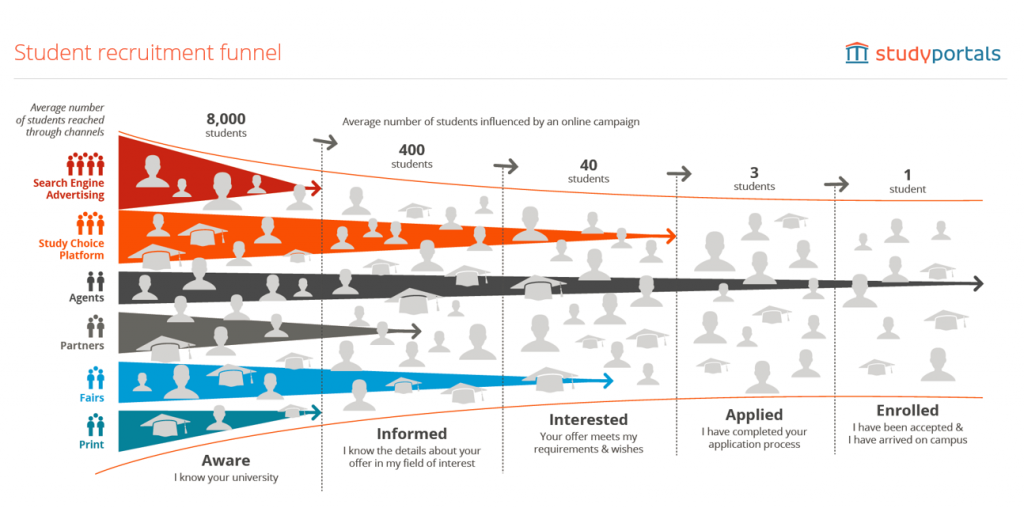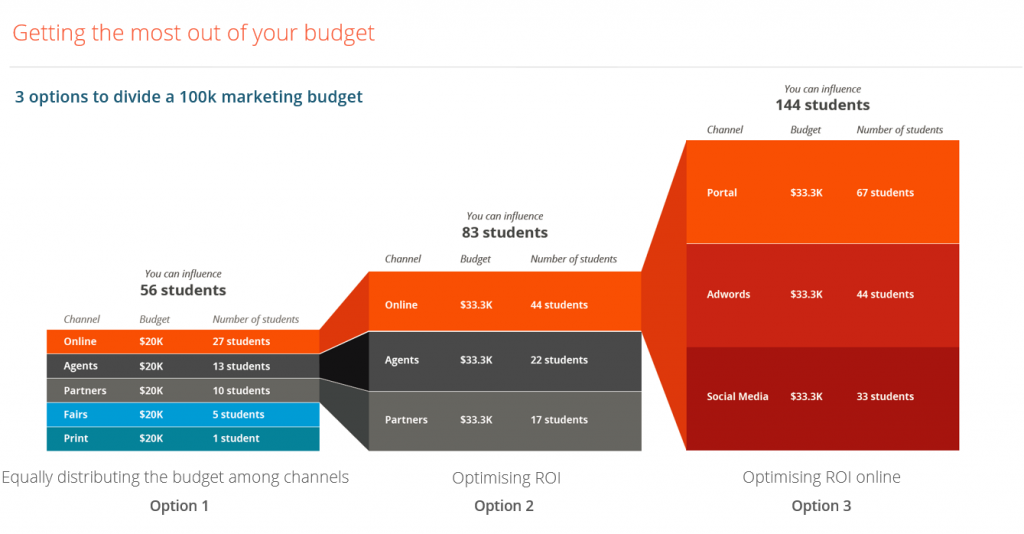Smart ways to invest your student marketing budget

The number of international students is expected to rise from 4.5 million in 2012 to 7 million in 2025. Because of this rapid growth, higher education institutions must adapt their marketing strategy towards targeting the right and qualified students. Effective marketing means going where your target audience is and knowing how they will find you. Recruiting prospective students through online marketing activities enables institutions to reach study seekers all over the world.
However, with growing competition, institutions find it difficult to manage marketing campaigns, especially when the budget is tight, or when marketing isn’t considered a high priority. That’s why universities need to start making smarter decisions regarding their budget investments in a manner that increases their return on investment (ROI). We’ve compiled a small guide on how to get the most out of your budget.
Student recruitment funnel
Before you start investing in marketing tools, you should decide and evaluate which channels work best for reaching your desired target group. Moreover, it’s important to see what steps and processes students take from beginning to end; or, in other words, what path or journey they take before they eventually enrol. The student recruitment funnel in our infographic gives you an overview of how different channels reach prospective students at different stages. As you can see, the most effective marketing channel is not necessarily the one that delivers the most traffic. Some channels might, for example, boost awareness among visitors; but then, only a few users will click through to your programme website or actually apply. Other channels, might help you directly enrol students, but might have a very small reach. For more details, check out our article on ‘The student recruitment funnel: 5 steps towards enrolment’.
Getting the most out of your budget
There are several ways for you to spend your budget. However, the way that allows you to reach a high number of qualified prospective students is to direct your focus towards the most effective channels. Investing budget in online marketing when effective for your university, can increase your conversion rate, moving prospective students and applicants through the student recruitment funnel. As a result, the number of students who enrol in your study programme grows significantly.
So, what are some ways and options for investing money in online marketing channels? Below we’ve compiled an example that we showcased at previous EAIE and NAFSA conferences, consisting of three options for dividing a 100K marketing budget, based on experiences and insights provided by some of our partner universities. Please note these numbers are indicative, and each and every university will have a different conversion rate per channel, depending on their country, university reputation, brand awareness, marketing budget, team size and expertise and so forth.
Option 1
As shown in the infographic, allocating your budget equally among all channels – namely, online, agents, partners, fairs, and print – could, for instance, allow you to reach approximately 56 students.
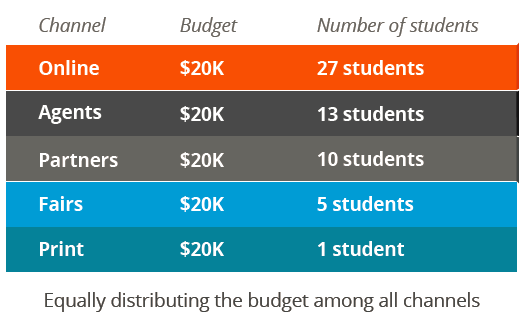
- Print advertising, while one of the most traditional means of recruiting students, and good for showcasing a university’s brand is usually a very difficult medium to track, and requires rather high time-investments as well as large investments in printing, and local media buying, which usually means enlisting local advertising agencies.
- Fairs are another popular channel for recruiting international students, yet are rather costly and time-consuming as it involves a lot of human resource investments. Attending fairs requires the physical presence of at least one member of the marketing team, which usually means significant travel time and costs. Furthermore, attending fairs in all the key markets universities would like to recruit from is rather difficult to scale, especially when aiming for a diverse international student population.
- Partners are another popular way of attracting new international students, and universities usually need to leverage their partner networks and maintain long-term relationships with other partner universities to ensure a constant flow of students.
- In some markets, universities resort to using agents for recruiting international students, who can guide students through the entire student journey. For some universities, maintaining large networks of agents is usually rather time-consuming as they need to ensure the agent’s reliability, maintain good relationships and assess the quality of the students referred to the university. Agents also usually work with more than one university at a time, so there is usually a price sensitive component involved in these partnerships.
- Last, for some universities that are interested in diversifying their student population, online marketing is an increasingly popular and efficient tool as it allows universities to reach out globally to prospective new students and tailor campaigns for each study programme. Online marketing does require a digital set of skills and expertise in order to ensure campaign optimisation, yet is easier to track and improve in terms of conversions.
One problem with this approach is that being active on all five channels requires a lot of time and effort. After setting up the right strategy for each channel, it is also required to keep monitoring them actively. Whereas online channels reach the highest number of students, the numbers for fairs and print marketing are relatively low. All channels require a lot of preparation; yet, based on the outcome, it is unwise to spend your budget equally.
Option 2
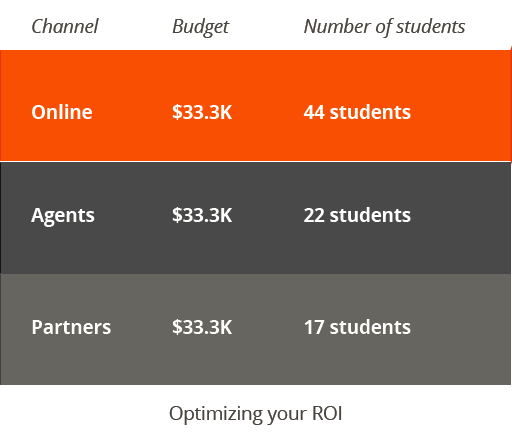
Another option involves excluding the channels that require too much effort with little return. You should rather focus your energy on the channels that assure a better ROI, resulting in you reaching more students. With this option, your marketing activities are more precisely directed to your target group. With online channels, agents, and partners, you could reach about 27 more students on average than you would with option 1. Clearly, shifting your focus to only a few chosen channels already generates a dramatic increase in your ROI. Online channels do require a marketing team that is proficient at setting up cross-platform tracking, CRM investments, and a skilled team who understands analytics and conversion rates.
Option 3
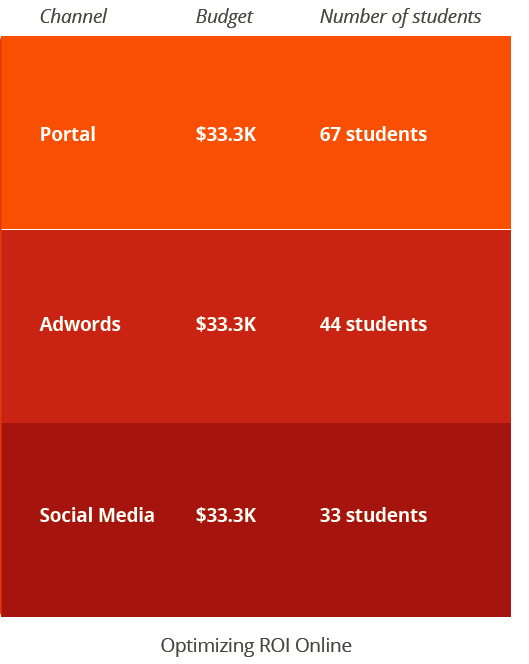
Focusing your marketing efforts solely on online channels gives you the advantage of reaching students on a global scale. In return, a higher number of students are aware of your campaign and are informed of your educational offers. Investing your $100k budget equally in social media, AdWords, and a study choice platform like Studyportals can expand your reach to an impressive number of students (144). Whereas AdWords and social media already have the capacity to reach a remarkable number of students, Studyportals, as a global study choice platform, can achieve for example the highest reach with nearly 67 students. By offering over 23 million users the opportunity to search for their dream education on our platforms, prospective students are empowered to find a university that best fits their educational needs. The advantage of adopting an online multi-channel strategy is that the communication, reach, and marketing is (mostly) unrestricted by the limits of location or time difference.
A big part of investing in student marketing is knowing how to establish awareness of your university; but, that’s not all it is. It’s also about understanding where your students tend to be and how they tend to search for their education. So, when you’re deciding how you are going to split and allocate your student marketing budget, always place a strong emphasis on the methods that boost your ROI. This advice may seem obvious; but in the age of online, digital marketing and a global marketplace for education, you would be surprised how many universities stick with the old methods of giving out flyers and doing on-campus recruitment. These days, it’s all about building an online presence that is active with students and has the ability to reach them where they already are.
For more updates, follow us!
